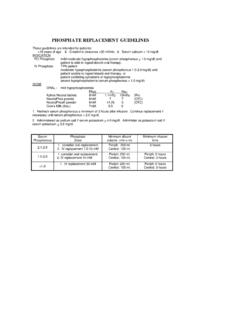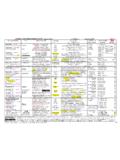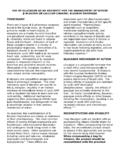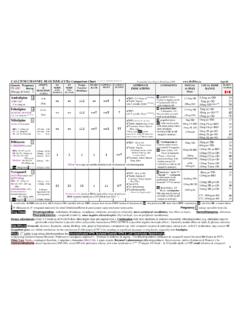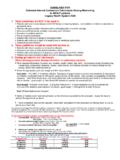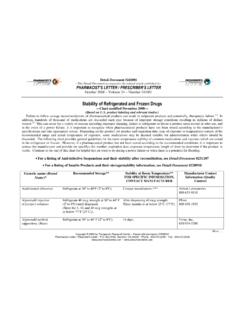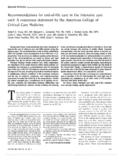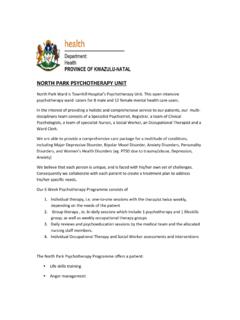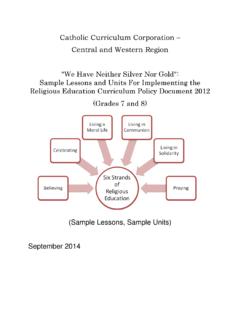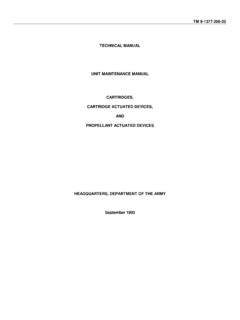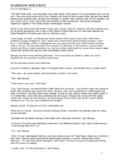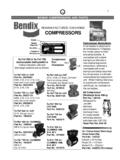Transcription of Vasoactive drugs in the intensive care unit Cheryl …
1 Vasoactive drugs in the intensive care unit Cheryl L. Holmes Purpose of the review Introduction Vasoactive drugs are the mainstay of hemodynamic The purpose of Vasoactive drug therapy in the intensive management of vasodilatory shock when fluids fail to care unit (ICU) setting is to restore tissue perfusion in restore tissue perfusion. In this review, studies published shock states. Hypovolemic, cardiogenic, and obstructive during the past year that increase our understanding of the forms of shock are characterized by decreased cardiac out- use of Vasoactive drugs in the intensive care unit are put, arterial pressure, and profound vasoconstriction in the discussed. peripheral circulation. In vasodilatory shock there is a com- Recent findings plex interaction between pathologic vasodilation, relative In septic shock, there is no benefit in increasing mean and absolute hypovolemia, myocardial depression, and arterial pressure from 65 to 85 mmHg.
2 Norepinephrine did altered blood flow distribution, which occur as a conse- not worsen renal function. Epinephrine induced visceral quence of the inflammatory responsive to injury [1 ]. hypoperfusion and hyperlactatemia, and worsened organ Sepsis is the most frequent cause of vasodilatory shock;. function and survival compared with norepinephrine and however, vasodilatory shock is also the final common path- vasopressin. There are a number of reports of the safety way for prolonged and severe shock of any cause [2]. and efficacy of vasopressin but it is not currently recommended as first line therapy, and if used, should be The hemodynamic management of shock is aimed at given as a continuous low dose infusion.
3 Terlipressin is maintaining oxygen delivery above a critical threshold showing promise but decreases cardiac output. and increasing mean arterial pressure (MAP) to a level Metaraminol is being investigated as an alternative to that allows appropriate distribution of cardiac output for norepinephrine. Dopamine may improve splanchnic flow adequate organ perfusion. Vasoactive drug therapy in the mainly by increasing cardiac output. Dobutamine improves treatment of shock states aims to increase oxygen delivery oxygen delivery and may improve mesenteric blood flow. or increase organ perfusion pressure or both. Summary Over the last 40 years, there have been few controlled Vasopressor agents increase MAP, which increases organ clinical trials to guide clinicians on the use of Vasoactive perfusion pressure and preserves distribution of cardiac drugs of treating shock states.
4 It is not known whether the output to the organs. Maintenance of an adequate sys- currently favored combination of norepinephrine and temic pressure is essential for adequate tissue perfusion. dobutamine is superior to traditional therapy with When MAP falls below the autoregulatory range of an dopamine. Epinephrine is not recommended as the first-line organ, blood flow decreases, resulting in tissue ischemia therapy. The role of vasopressin and terlipressin remains and organ failure. Vasopressor agents also improve cardiac unknown. Three large ongoing clinical trials will be output and oxygen delivery by decreasing the compliance completed soon and the results should clarify the role of of the venous compartment and thus augmenting venous these various agents.
5 Return. Keywords Ventricular function can also be decreased in vasodilatory dobutamine, dopamine, epinephrine, metaraminol, shock states either from a previous condition, or from myo- norepinephrine, sepsis syndrome, septic shock, cardial depression due to sepsis. Because oxygen delivery terlipressin, vasopressin is dependent on cardiac output, the successful resuscita- tion of these patients depends on identifying left ventric- 417. 2005 Lippincott Williams & Wilkins. Curr Opin Crit care 11:413 ular dysfunction and correcting it by the use of inotropic agents [3]. Department of Medicine, University of British Columbia and Department of Medicine, Kelowna General Hospital, Kelowna, British Columbia, Canada Correspondence to Cheryl L Holmes, MD, FRCPC, Director, Critical care Medicine, Kelowna General Hospital, 2268 Pandosy Street, Kelowna, V1Y 1T2, Vasopressor and inotropic support in British Columbia, Canada vasodilatory shock Tel: 250 212 9450; fax: 250 860 0848; e-mail: Although many vasopressors have been used since the Current Opinion in Critical care 2005, 11:413.
6 417 1940s, few controlled clinical trials have directly compared Abbreviations these agents or documented improved outcomes due to GMP gastric mucosal perfusion their use [4 ]. Thus, the manner in which these agents ICU intensive care unit MAP mean arterial pressure are commonly used largely reflects expert opinion, animal 2005 Lippincott Williams & Wilkins. data, and the use of surrogate endpoints such as tissue 1070-5295 oxygenation as a proxy for decreased morbidity and mortality. 413. 414 Cardiovascular system An evidence-based consensus of vasopressor and inotropic out of favor in the treatment of vasodilatory shock due to support in septic shock was recently published by a sub- their long half-life and vasodilatory properties [1 ,8 ].
7 Committee of the Surviving Sepsis Campaign [1 ,5 ]. The authors acknowledge making recommendations about Norepinephrine the choice of individual vasopressor agents in septic shock Norepinephrine is a potent a-adrenergic agonist and less is made difficult by the paucity of controlled trials and by potent b-adrenergic agonist and is considered first-line the clinical reality that agents are frequently used in com- therapy for the maintenance of blood pressure and tissue bination' [1 ]. Based on the available evidence they make perfusion in septic shock [8 ]. Traditionally, dogma rec- the following recommendations: ommended that norepinephrine be avoided at all cost, as this agent caused severe vasoconstriction.
8 However, data (1) Vasopressor therapy should be started when an appro- suggest that this is incorrect [9]. priate fluid challenge fails to restore an adequate arterial blood pressure (Grade E). The renal effects of norepinephrine were investigated in (2) Low dose dopamine should not be used for renal pro- 14 patients with septic shock and compared with 12. tection (Grade B). uninfected patients with head trauma in whom norepi- (3) Epinephrine and phenylephrine should not be used as nephrine was infused to maintain cerebral perfusion pres- first-line vasopressors in septic shock (Grade D). sure [10 ]. Norepinephrine reestablished urine flow in 12. (4) Dobutamine is the agent of choice to increase cardiac of the 14 septic patients with a decrease in serum creat- output in septic shock (Grade E).
9 Inine levels and an increase in creatinine clearance rate (5) Inotropic agents should not be used to increase car- after 24 hours. Urine parameters were not affected in diac output above physiologic levels (Grade A). the head trauma group. This study demonstrates the beneficial effects on renal function that accompany Two areas of uncertainty are described: (a) Whether the norepinephrine-induced vasoconstriction in septic shock. combination of norepinephrine and dobutamine is supe- rior to dopamine in the treatment of septic shock, and Epinephrine (b) whether vasopressin should be administered as vaso- Epinephrine is a potent a and b-adrenergic agent that is pressor therapy in septic shock when conventional vaso- not considered first-line therapy for septic shock because pressor therapy fails.
10 Three large continuing trials in of its detrimental effects on regional circulation and blood patients with septic shock are comparing epinephrine to lactate levels [1 ]. It should be used for cases of extreme combined dobutamine and norepinephrine, dopamine to hemodynamic collapse. norepinephrine [6 ], and vasopressin to norepinephrine. In a hyperdynamic animal model of sepsis, the effect of Mean arterial pressure goals epinephrine on regional circulation was studied [11]. MAP is commonly used as a surrogate of organ perfusion in Although epinephrine increased cardiac output, blood pres- shock states; however, the recommended endpoints with sure, and myocardial performance, it was also associated regard to MAP remain controversial.
